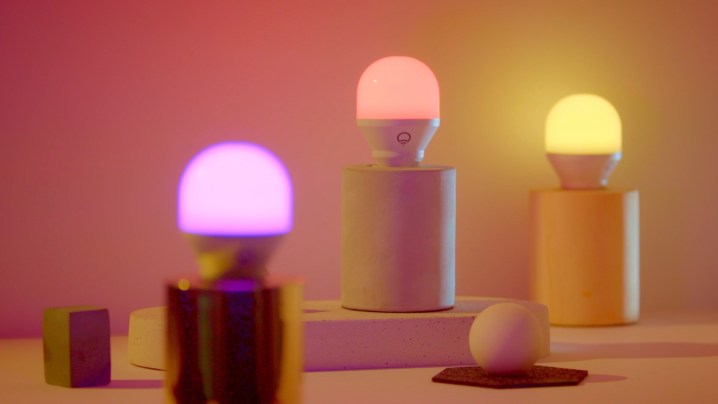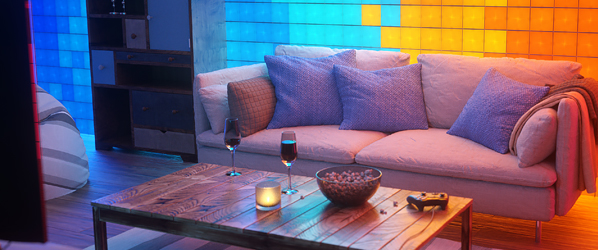Ambient lighting is most simply thought of as “indirect lighting.” It’s lighting that isn’t focused directly on an object and is used to add to the available amount of light in a room. You can use ambient lighting as part of ceiling-mounted fixtures or floor lamps to brighten or even out the light in a room. Ambient lighting can also be placed behind an object and used to bounce light off a wall or the ceiling. Think of it as the lighting that takes your room from plain to warm and inviting.
Benefits of smart ambient lights
While adding ambient lighting to a room can help transform it from simple to extraordinary, smart ambient lighting is definitely the way to go. The main reason is that smart lighting can be programmed to look precisely how you want it and turn on when you want. Not only can you control the brightness and intensity of the light, but also the color.
You can light up the back of your TV set and have it change color depending on your programming. You can also take things a step further by combining the system with a voice assistant and have several pre-set routines that change the lighting in the room with a single command. “Turn on horror movie lighting,” is just one example of how it could accent movie night.
Setting up ambient lighting

The first step is picking up the style of ambient lighting that will work for the area you wish to light. Smart ambient lights come in a few different styles, and some will work better than others, depending on the specific usage and limitations of the space in question.
Strip lighting is very popular; it generally comes in spools that can be connected to one another and often has a sticky tape-like surface you can use to mount it to any smooth surface. Most kits will come with a small remote that allows you to access features. Some brands also offer apps to provide even more control. In all cases, you can hook them to a smart plug to allow you to control them uniformly — even by voice command.
Lamp or bulb-style smart lights are also easy to use anywhere. Many of these types of lights have the ability to screw into an existing outlet or have a small stand so you can place them on the ground or a table and point them upwards. Most will have a remote or app control, and again, you can combine them with a smart plug to allow voice assistant or Google Home, Apple HomeKit, or Amazon Alexa control.
A recent addition to the market is the LED panel. These lights can be attached to one another to make an art piece for your wall and also create ambient light. They have a remote, you can connect them to your Smart Home network, and they will generally have an app.
How to choose ambient smart lights
While there are many options on the market, here are a few products that might help you get started:
Philips Hue Starter Kit — The Hue starter kits contain three or four smart bulbs that screw into existing light sockets and the Hue Bridge (a little router that controls the lights and allows you to connect to them with your phone). You can get a variety of shades of white as well as color bulbs.
Philips Bloom Lamp — The Bloom is a small table lamp that provides white or colored lighting and can be paired with a Hue Bridge or connected to your smart home setup via Bluetooth.
LIFX Lightstrip — The LIFX Lightstrip lights work well for under counters or behind your TV or couch. They come in a variety of lengths.
Govee Indoor-Outdoor light strip — These light strips come in different lengths and can be connected together. There’s a control unit built into the plug, and it also includes a remote control unit.
Govee Glide Hexa Pro — These Hexagonal panel lights are capable of multiple colors within a single panel, so you can arrange them in patterns to suit your space.
Nanoleaf Shapes/Elements — These panel lights come in packs of five or seven, with all the equipment to install them. With enough units, you can start to create unique wall art that will catch the eye and also provide lighting.
How to place ambient light
For the most part, you’ll likely be setting up your ambient lighting behind or under things in order to get the light to bounce off a wall or object. It’s becoming more common to see kitchen cabinets with lighting attached to the underside, which bounces the light off of the wall and countertop. Other popular ideas are to place the ambient light behind your TV to light the wall, behind a sofa, or in a home office setting. Placing strip lighting along the underside of shelves in a bookcase will light up the entire area and show off your knick-knacks while adding some ambiance to the room. You can even buy fancy tracks that the strip lights can sit inside.
Another idea is to pick up “panel” kits. These are sets of lights that are usually modular and allow you to add more lighting. Products like the Govee Glide Hexa Pro or Nanoleaf’s Shapes/Elements LED panels are, in essence, art pieces that you hang on the wall that also contain LED lighting you can control with a remote or through their respective apps.
Read more about how to place ambient lighting by room. You can also add wireless switches to control the light from a wall if you want that option, too.
Using a voice assistant with ambient lighting

These days, most lighting kits will work with any brand of voice assistant, but you still need to double-check that it will be compatible with your smart home hub setup. If the lighting pack is smart home-enabled, there will be a setup process, usually involving creating an account with that company’s app. From there, you’ll typically connect to your assistant and link up the light to that app. You can add the light to a room setup, use it in routines, or control it directly from the app.
For a fully hands-free setup, you’ll likely be setting up routines to turn the lights on or modify their colors based on a specific time of day, a voice command, or perhaps even when it senses you enter the room. The beauty of smart-home routines is that you’re often only limited by your imagination. If you love Christmas, you can create a routine so that when you say “Ho Ho Ho,” the room will turn red and green, your tree will light up, and your speakers will fill the room with the sound of Bing Crosby singing holiday tunes.
Smart ambient lighting is a great way to add warmth and color to any room. Using it to create areas within a room with designated lighting takes things up a notch. Experiment with what’s out there; in no time, you’ll have an Instagram-worthy space your friends will drool over.




